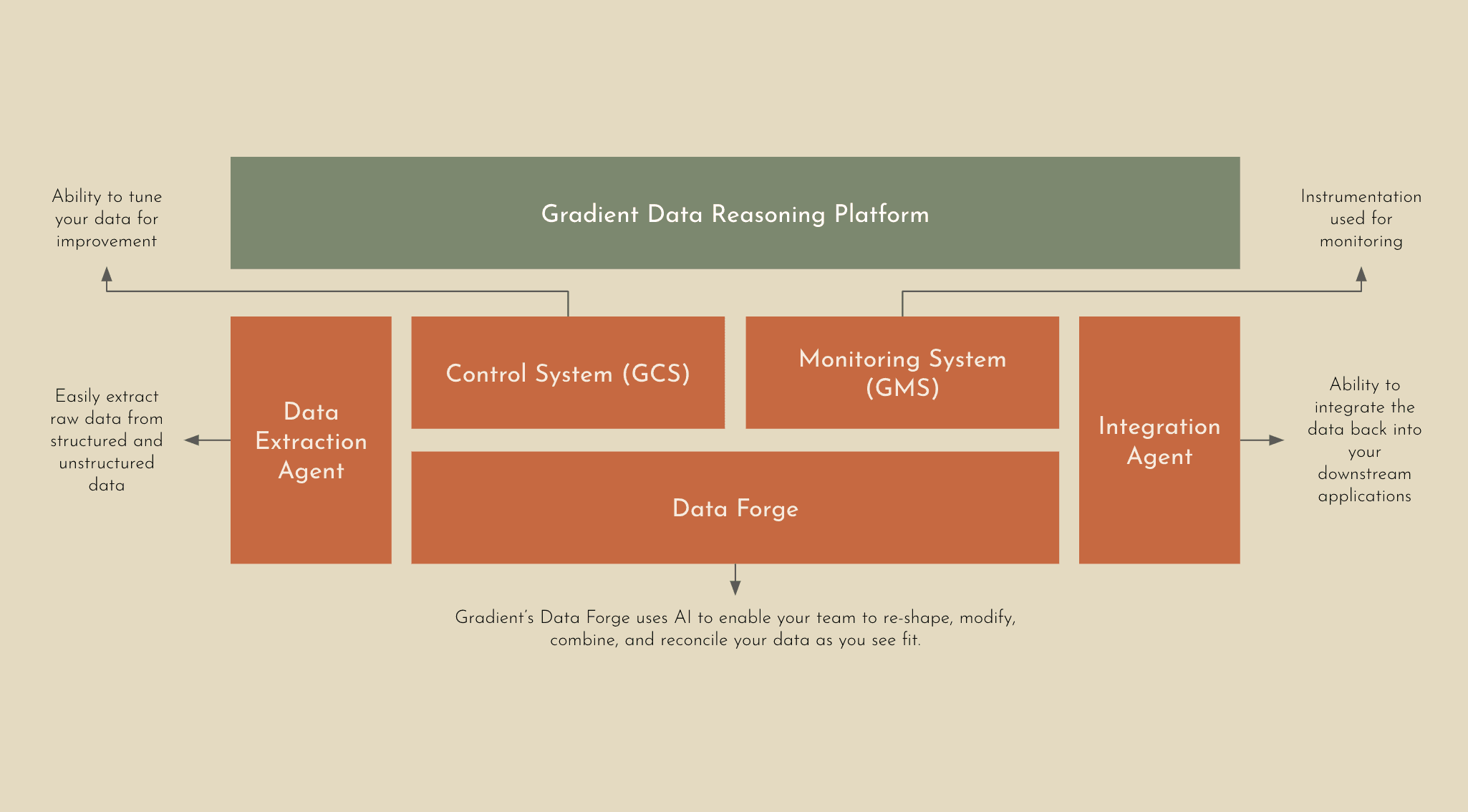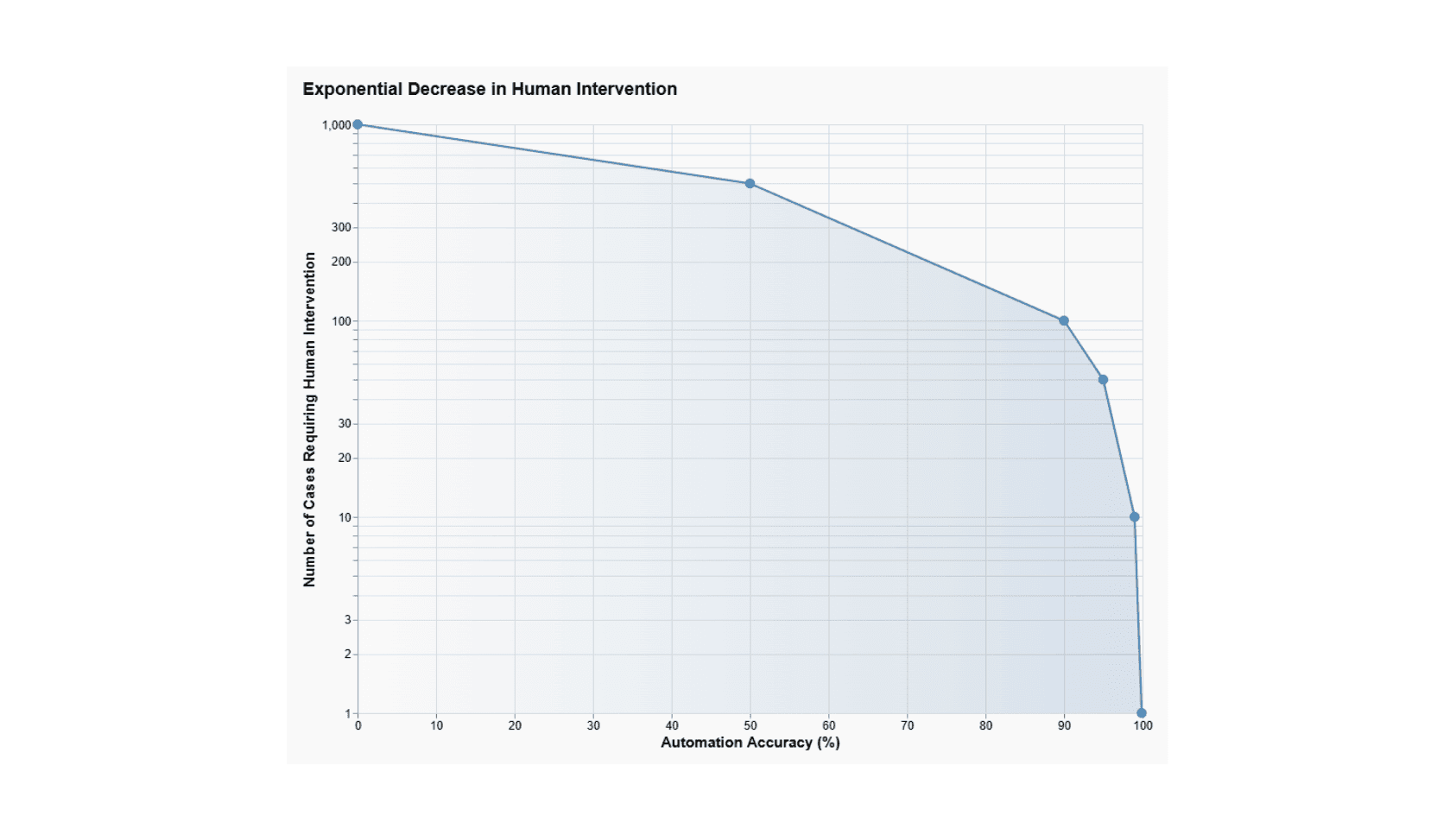AI Deep Dive
Nov 11, 2024
•
5 min read
Is Data Reasoning What You Need? Find Out by Asking Yourself These 5 Questions
Quick Primer: What is Data Reasoning?
For those unfamiliar with data reasoning, it’s the practice of applying logic and context to data to uncover meaningful insights, support informed decision-making, and streamline complex workflows. Unlike basic data processing—which might handle simple calculations or aggregations—data reasoning takes it a step further, using advanced operations to interpret data and help you integrate institutional knowledge into your workflows. This can involve uncovering relationships between data points, forecasting future trends, analyzing sentiment, or integrating unstructured data from various sources to produce actionable insights.
In essence, data reasoning requires more than just access to data; it requires the ability to process, interpret, and derive meaning from data in ways that align with specific business goals. And by data, we mean all types—both structured and unstructured. This process is especially valuable in cases where data alone cannot yield straightforward answers but requires deeper analysis and contextual understanding to guide decisions. Take a look at some examples that we’ve seen from some of our customers.
Regulatory Compliance: Organizations must analyze contracts, legal texts, and compliance frameworks to ensure they meet local jurisdictions and global standards. This is a data reasoning workflow that involves interpreting legal language and identifying potential compliance risks and vulnerabilities.
Quality Control and Monitoring: In industries like manufacturing, companies collect sensor data, as well as historical ticket data or recent work notes on the machinery. A data reasoning workflow might analyze all the sources of data together to detect anomalies, predict / triage equipment failures, and prevent costly downtime.
Customer Intelligence: Companies often collect customer data from various touchpoints. A data reasoning workflow here could leverage all structured and unstructured data to infer customer preferences and drive personalized marketing campaigns based on the findings. In a nutshell, you’d be building a comprehensive 360-profile of your customer.
These workflows play a critical role in driving value for businesses, but the complexity requires a tremendous amount of time, advanced tooling, and a staffed ML team to automate at scale. However for most businesses, these aren’t simple hurdles that can be overcome easily, which makes it extremely difficult for teams to scale and move quickly.
5 Questions You Should Ask Yourself
To help you decide if data reasoning is something your organization might want to consider, here are five questions you should ask yourself. Each question highlights an area where data reasoning could drive significant improvements in efficiency, accuracy, and strategic decision-making within your business.
1. Do Your Business Goals Fall Into One of These Two Buckets?
Data reasoning unlocks new possibilities for enterprise businesses, especially if you are looking for ways to improve your bottom line. Most businesses that leverage data reasoning in their workflows often find success in:
Reducing Overall Costs: Regulatory compliance or manual processes that are critical to business operations and require substantial people to run.
Creating New Revenue Generating Opportunities: New data or automation features that improve product quality and customer experience.
Consensus: Data reasoning can be used to reduce overhead and help create new revenue opportunities. If these business goals are important to your team, it’s worth a shot to look into how data reasoning could help you support these goals.
2. Are There Manual Tasks That Are Consuming Too Much Time?
Routine, repetitive tasks can consume a large portion of your team’s resources. Data reasoning is ideal for unlocking the data needed to automate complex operational tasks, reducing overhead and allowing your team to focus on more strategic initiatives. While most will assume that Robotic Process Automation (RPA) is the answer, RPA operates on predefined rules and has limited contextual understanding - making it extremely difficult or impossible to automate tasks that are far more sophisticated. According to a recent study from Deloitte, 69% of RPA projects generally fail due to data complexity.
Consensus: If you’re looking for a solution to automate a manual or repetitive task that relies heavily on data, data reasoning is for you.
3. Do Your Tasks Require Higher-Order Reasoning?
Data reasoning is designed for tasks that need go beyond simple calculations and a simple plug-and-play framework. Higher order operational tasks generally go through a multi-step process where logic and context is applied to your data to draw insight. Some examples may include:
Sentiment Analysis: Interpreting the tone or emotional context of data.
Forecasting: Ability to take existing or historic data to forecast future trends.
Insight Generation: Synthesize conclusions and insights from disparate pieces of information.
Entity Recognition: Identifying key entities (people, organizations, etc.) from unstructured data.
Inferring Relationships: Understanding how different data points relate to each other, such as cause-and-effect or correlations.
For most, this will either be a manual process or it will require a fully staffed data science and machine learning team to execute.
Consensus: Companies often avoid automating tasks that require higher-order reasoning due to the complexity or lack of technical expertise. However if there was an easy way to make this possible, what are some tasks that you would have in mind?
4. Are You Dealing with High-Context Scenarios That Require Measuring Qualitative Information?
When your data involves complex, context-rich information (such as subjective, qualitative data), data reasoning is a perfect solution for transforming this into measurable insights. Whether you need to analyze customer feedback or compare nuanced data from diverse sources, a data reasoning platform can automate much of the data wrangling, making it easier to gain insights from complex information. This can be particularly useful if you’re trying to integrate subjective metrics into your quantitative analyses to create more well-rounded, actionable output.
Consensus: Not all tasks are black and white and may require subjective metrics. Data reasoning applies logic and reasoning to your data to help navigate these nuances. By using platforms like Gradient, you’ll also be able to provide human-feedback in order to align the model to improve accuracy and deliver the desired outputs.
5. Are You Leaving Data on the Table?
Many organizations possess vast amounts of data that aren’t fully utilized due to their inability to tap into the unstructured nature of their data. According to Gartner, 80% of enterprise data is unstructured - leaving valuable information and institutional knowledge untouched or forgotten. If this sounds familiar, leveraging a Data Reasoning Platform like Gradient can help you unlock the latent potential of this data. By making sense of unstructured data, you can uncover trends, patterns, and correlations that were previously hidden, ensuring that no valuable data goes to waste. Below are just a few examples of unstructured data, regardless of which industry you’re in.
Documents and PDFs: Contracts, reports, manuals, and scanned documents often lack structured organization, making it difficult to parse information without specialized tools.
Emails and Messages: Messages, attachments, and metadata in emails lack a standardized format, making it challenging to analyze and extract insights without advanced processing. Messages present similar challenges if not more, since they are often scattered due to the consistent back and forth nature of communication.
Audio, Video, and Images: Recordings from calls, meetings, or videos contain rich, unstructured data that requires transcription and analysis tools to interpret. Images are also difficult to interpret and require logic to analyze and present a consensus of the message that it’s trying to tell.
Customer Support Tickets: Text from customer service chats, complaint forms, and service notes are usually unstructured, containing valuable but hard-to-analyze information about customer sentiment and issues.
Consensus: Your ****institutional knowledge is your most valuable asset! ****Don’t let raw and unstructured data stop you from maximizing the ROI from your data and unlocking new possibilities.
Introducing Gradient’s AI-Powered Data Reasoning Platform
If one or more of these questions resonated with you, data reasoning is definitely something you should look into. However, the data reasoning process is not simple which is why Gradient developed the first AI-powered Data Reasoning Platform that’s designed to automate and transform how enterprises handle their most complex data workflows. Powered by a suite of proprietary large language models (LLMs) and AI tools, Gradient eliminates the need for manual data preparation, intermediate processing steps, or a dedicated ML team to maximize the ROI from your data. Unlike traditional data processing tools, Gradient’s Data Reasoning Platform doesn’t require teams to create complex workflows from scratch and manually tune every aspect of the pipeline.
Schemaless Experience: The Gradient Platform provides a flexible approach to data by removing traditional constraints and the need for structured input data. Enterprise organizations can now leverage data in different shapes, formats, and variations without the need to prepare and standardize the data beforehand.
Deeper Insights, Less Overhead: Automating complex data workflows with higher order operations has never been easier. Gradient’s Data Reasoning Platform removes the need for dedicated ML teams, by leveraging AI to take in raw or unstructured data to intelligently infer relationships, derive new data, and handle knowledge-based operations with ease.
Continuous Learning and Accuracy: Gradient’s Platform implements a continuous learning process to improve accuracy that involves real-time human feedback through the Gradient Control System (GCS). Using GCS, enterprise businesses have the ability to provide direct feedback to help tune and align the AI system to expected outputs.
Reliability You Can Trust: Precision and reliability are fundamental for automation, especially when you’re dealing with complex data workflows. The Gradient Monitoring System (GMS) identifies anomalies that may occur to ensure workflows are consistent or corrected if needed.
Designed to Scale: Typically the more disparate data you have, the bigger the team you’ll need to process, interpret, and identify key insights that are needed to execute high level tasks. Gradient enables you to process 10x the data at 10x the speed without the need for a dedicated team or additional resourcing.
Even with limited, unstructured or incomplete datasets, the Gradient Data Reasoning Platform can intelligently infer relationships, generate derived data, and handle knowledge-based operations - making this a completely unique experience. This means that teams can automate even the most intricate workflows at the highest level of accuracy and speed - freeing up valuable time and overhead.
Under the Hood: What Makes it Possible
The magic of the Gradient Data Reasoning Platform is its high accuracy, quick time to value, and easy integration into existing enterprise systems.
Data Extraction Agent: Our Extraction Agent intelligently ingests and parses any type of data into Gradient without hassle, including raw and unstructured data. Whether you’re working with PDFs or PNGs we’ve got you covered.
Data Forge: This is the heart of the Gradient Platform. AI automatically reasons about your data - re-shaping, modifying, combining, and reconciling your structured and unstructured data via higher order operations to achieve your objective. Our Data Forge leverages advanced agentic AI techniques to guide the models through multi-hop reasoning reliably and accurately - contextualizing the institutional data and grounding it to elicit the best output.
Integration Agent: When your data is ready, Gradient will ensure that your data can be easily integrated back into your downstream applications via a simple API.

With Gradient, businesses can focus on the outcomes—whether it’s driving customer insights, ensuring regulatory compliance, or optimizing production lines—without getting bogged down in the operational intricacies of data workflows. By automating complex data workflows, organizations can achieve faster, more accurate results at scale - reducing costs and enhancing operational efficiency. In a world where data complexity continues to grow, the ability to harness that data through automation is not just a competitive advantage—it’s a necessity.
Share
Tags






